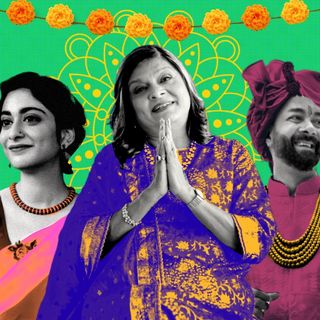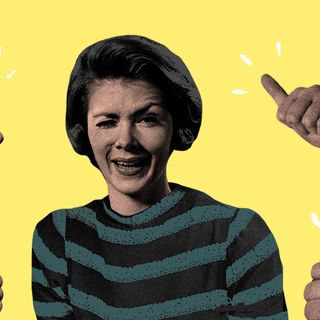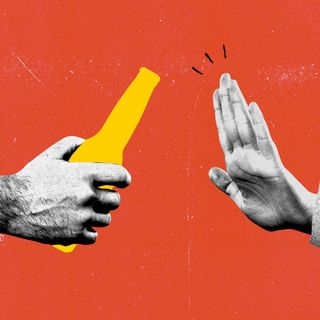
Reclaiming Cringe: Were Bangs Always Cool?
Even if they’ve evolved to become the epitome of the hapless sad girl, bangs never lost their characteristic feature of rebellion and change.

A series where we discard shame around the objects, activities, and proclivities that others consider deeply uncool.
Zooey Deschanel made them, quite literally, the face of the manic pixie dream girl. Over time, this was the death knell for bangs — a hairstyle that became cringe for its association with women who needed to emphasize their quirkiness and personality at the expense of other women. But bangs remain the most enduring style that we never want to openly admit to wanting, even today — and it turns out, the desire for bangs was never really about hair at all.
A case for reclaiming bangs would start with the fact that they’ve been around for over 100 years (1000s, if it’s true that the ancient Egyptians preferred bangs as their hairstyle of choice). But so are several other, less desirable things, one might argue. This is fair, but what other type of artifact has been repeatedly seen both on punk feminists — like Le Tigre, and on some of the most iconic celebrities of the century — like Audrey Hepburn, the film adaptation of Cleopatra, Jane Birkin, and closer home, Zeenat Aman, Sridevi, and Rekha? What most of these women had in common wasn’t their hairstyle — it was, in fact, their sensibility, their worldview, and, by extension, their politics.
“Short bangs kind of come out of a reactionary or revolutionary standpoint, and if you look back in history, from Joan of Arc to Louise Brooks in the 1920s to Betty Page and the sexuality she represented to women with Chelsea cuts, bangs have always represented physical defiance,” Sean Flynn, a hairstylist, told The Cut.
There’s a reason — bangs signal the willingness to dramatically experiment with hair, one of the most enduring symbols of femininity. By extension, bangs are an experiment in femininity itself. “In the 1600s, bangs were a controversial statement as the conservative clergy regarded women who cut or curled their bangs to be on their way to committing a mortal sin,” CR magazine noted.
This should have remained cool. Instead, when bangs started becoming an all too common coping mechanism for people trying to find a short-term way out of deeper distress, the Internet began to find it hilarious.
Related on The Swaddle:
For Women, a Shaved Head Isn’t About Getting Attention; It’s About Being Seen
It started with one Tweet bringing this observation to light. “Personally, I believe wanting bangs is almost never about wanting bangs, and if [you] want bangs [you] should go to therapy first,” writer Allie Wach tweeted back in 2018, starting a watershed moment in discourse when bangs became symbolic of sad women whose depression haze sent them to the hairdresser instead of a therapist, in search of a dramatic makeover to feel something. And that something seemed to be, to the outside world, the persona of a cheery, twee woman with a deep past — inadvertently, the manic pixie dream girl.
As The Atlantic put it: “Cutting off the front of your hair is the ultimate expression of self-delusion, a desperate attempt to right something deeply wrong — with a pair of scissors.” Bangs, then, began to signal something seemingly different from the rebel-punk aesthetic of the previous century: they became a way to feel rebel-punk when life just felt too depressing or bleak. It became a trope, one that prompted celebrity hairstylists to advise women never to cut bangs when they’re depressed.
“I looked at myself in the mirror. I looked older and sad, and I felt those things, too. I felt like I needed a big change… And after this past year, I couldn’t go on with things like they were. My long, untended hair hung around my face, and I thought about what it would be like to pretend that a few snips of the scissors could rewind the hands of time,” wroteRachel Mans McKenny, a writer who went to therapy and got bangs.
But at its heart, this is what the impulse for bangs is about: the need to see tangible change when looking in a mirror. It’s less a cry for help so much as it is about taking ownership of one’s appearance — which, for women, is one of the most weaponized aspects of their lives — to signal change from within. It’s a response to feeling stuck in a miasma of an oppressive sameness that sometimes settles around women who comply, but who find themselves given the short end of the stick for reasons to do with their femininity — the breakup, the rejection, the elder-daughter obedience, the stifling of rage.
Even if they’ve evolved to become the epitome of the hapless sad girl, bangs never lost their characteristic feature of rebellion and change. And besides, they do urgently need to be reclaimed for other reasons, too: nobody, for instance, should ever equate them with TERFs and ruin a perfectly universal coping mechanism. But one thing is clear: no matter how much archetyping they suffer, bangs have, and always will, carry the undeniable pull of promising change, regardless of how the change looks. Because that’s seldom what it’s about.
Rohitha Naraharisetty is a Senior Associate Editor at The Swaddle. She writes about the intersection of gender, caste, social movements, and pop culture. She can be found on Instagram at @rohitha_97 or on Twitter at @romimacaronii.
Related


Is This Normal? ‘I Get Really Awkward When Someone Compliments Me’
